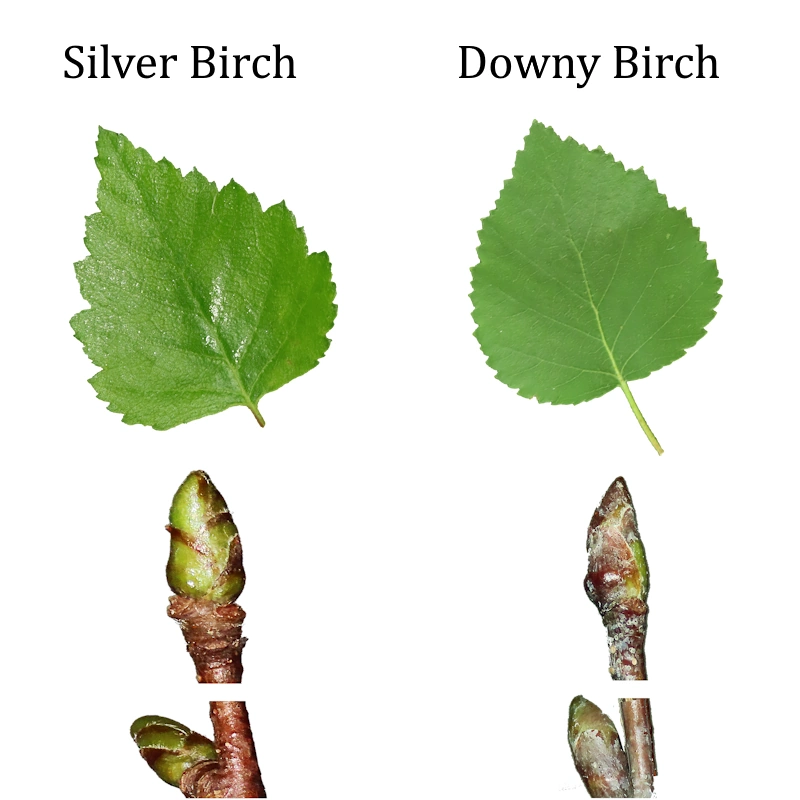Betula pendula
Common names: Silver birch
Irish name: Scots gaelic
Latin name: Betula pendula
Family: Betulaceae
Origin: Native
Tree type: Deciduous broadleaf tree
How it looks
Shape, bark, twigs
A mature tree can reach 30m in height and has drooping branches. The silver birch is known for its light, silvery bark, which sheds layers like tissue paper. As the tree matures, the bark develops dark arrow/ diamond-shaped marks (fissures) and becomes black and rugged at the base of the tree.
Buds
The buds alternate up the stem, 5-7 mm long, and are hairless. They are greener than the downy birch buds and point out from the branch, unlike the downy birch, which points up, in line with the branch.
Leaves
The leaves alternate up the stem and grow 2- 5 cm long. They are triangular and brighter green than downy birch leaves. Leaf stalks have no hair and are very short. The leaf margins are double-toothed, unlike the downy birch, which is single-toothed.
Flowers
Silver birch is monoecious, meaning male and female flowers (catkins) are found on the same tree. The male catkins are formed in the autumn and will remain on the tree all winter, only opening in April or May. They are long and brownish-yellow, hanging in groups of two to four at the tips of shoots. Female catkins are shorter, smaller and bright green, appearing in spring with the new shoots.
Fruits
Seeds are developed within the female catkins after successful pollination (by wind), causing them to thicken and change to a dark red. Each tree produces thousands of tiny seeds (2-3mm across) with two wings dispersed by the wind in autumn. These seeds can travel up to one mile from the parent tree.
Similar species
Downy birch (Betula pubescens)
Downy birch is more upright than silver birch, and the bark is browner in colour with more obvious horizontal grooves and lacks the papery quality of the silver birch. Downy birch has hairy buds and leaf stalks (hence the name), whereas silver birch is hairless.

Where to find it
In Ireland, the silver birch is less prevalent than the downy birch, as it favours well-drained soils. The silver birch is distributed across Europe, thriving in dry woodlands and heaths at lower elevations. This tree can tolerate a wide range of temperatures growing in both Spain and Lapland
Cultural importance
History | Myth | Literature
History
One of the earliest uses of birch recorded in Ireland is for the building of bog trackways in the Bronze-Age (c. 2200-800 BC). Birch continued to be used in this way throughout the Iron-Age (c. 800 BC-400 AD) and into the Medieval period (c. 400-1600 AD). Quantities of charcoal discovered in the midlands, demonstrate that birch, amongst other lighter woods, was also used for firewood during the Iron Age.
As birch was not considered economically valuable like oak, it was designated at one of ‘the commoners of the wood’ during the early Medieval period and was likely used as firewood during this period as well. It was also used to make brooms. The first letter of the early Irish ogham alphabet was named after the old Irish name for birch - ‘Beithe’ - and takes the following form:
Birch is very present in the Irish landscape not just physically but in terms of placenames. For example, Ballybay or Béal Átha Beithe, in County Monaghan, means ‘ford-mouth of the birch’, and Glenbeigh or Gleann Beithe, in County Kerry, translates as ‘valley of the birch’.
In the UK, there is evidence to suggest that birch bark was used as early as the Mesolithic period (c. 9000 – 4000 BC) to make woven mats, firelighters, torches and floats for fishing nets. Whilst in other European contexts, birch bark appears to have been used from the Palaeolithic (c. 185,000–135,000 years ago) up to the Medieval period in the production of tar for various waterproofing and adhesive purposes, such as the hafting of stone axes. In later periods, it was also used for tanning leather.
Myth, Legend and Folklore
In myth, legend and folklore throughout northern Europe, birch appears to be variously associated with birth, purity, love and rebirth. In Irish mythology, it features in the love story of Diarmuid and Gráinne where it is used to make their bed. It is used similarly in the story, ‘The Wedding of Maine Morgor, to celebrate Maine’s marriage to Ferb. Birch was also used in Ireland to protect against the fairies. As a symbol of rebirth, birch branches were used in Irish funerary practices and traditionally placed on the body of the deceased as they were carried to the grave.
In Scotland, birch was especially associated with St Bride or Brigid and used to make crosses for St Bride’s eve on January 31. In Wales, birch wreaths were given as a token of love. In other European countries birch samplings were placed in people’s houses to encourage abundance. As birch was associated with purity it was also used for protection against evil. Accordingly, in England, it was used to ‘beat the bounds’ of the parish to protect it from untoward spirits.
Literature
In the seventh-century nature poem written by the Irish King, Mad Sweeney or Suibhne Geilt, the birch is described as smooth, blessed, melodius, proud and delightful. In other Gaeilic poetry it is referred to as the ‘fair woman of the woods’. Birch features similarly in a fourteenth-century Welsh verse, by the poet Dafydd ap Gwylim, as a symbol of love. Indeed, the virtues of birch are the subject of numerous poems, including, The Birch Tree by James Russell Lowell, The Birches by Robert Frost, and The Sun and the Birch tree by Elizabeth Madox
Value to wildlife
Because of its light, wind-blown seeds, and love for growing in the sun, birch is nearly always the first tree to colonise treeless areas. As birch woodland grows, they provide lightly shaded areas for other tree and wildflower species to establish.
The two native birch species provide food and habitat for hundreds of insect species. The leaves attract aphids, which feed ladybirds and other species further up the food chain. The leaves are also a food plant for the caterpillars of many moths, including the angle shades and buff tips.
In spring, woodland birds flit from birch to birch, finding caterpillars for their young. The catkins of the silver birch are the preferred food plant of birch shield bugs and parent bugs.
The birch trunk is a popular nesting spot for hole-nesting birds, such as the greater spotted woodpecker. In the winter, birch seeds are eaten by siskins, greenfinches, and redpolls.
Birch trees are associated with specific fungi species, including the famous (and very poisonous!) fly agaric. The fungi with a red cap and white spots are often fed upon by slugs and small mammals, with no apparent effect from the substances that are so toxic to humans.
Threats
The species is not known to be threatened by any pest or disease in Ireland. To learn more about threats to Irish trees, visit ‘Threats to Trees.’
Uses
Silver birch has been widely planted as an ornamental or garden tree.
Birch wood is known for its durability and weight, making it a popular choice for crafting furniture, handles, and toys. Its timber is characterised by a light colour and is versatile, suitable for various applications such as high-quality pulp, sawlogs, and veneers.
Different parts of the birch tree have historical uses in herbal medicine. The bark was believed to have pain-relieving properties for muscle ailments, while the sap was applied to treat skin disorders. During spring, the rising sap was utilised to create wines, ales, and liqueurs, while the bark served for tanning leather.
Furthermore, the tree's young wood yields thin, paper-like sheets of bark with a waxy resin. This resin, even when damp, is easily ignitable, and when heated and cooled, it could be collected to produce a highly effective waterproof adhesive.
References
Fletcher, L., Milner, N., Taylor, M., Bamforth, M., Croft, S., Little, A., Pomstra, D., Robson, H. K. and Knight, B., 2018. The use of birch bark. Star Carr, 2, pp.419-435. DOI: https://doi.org/10.22599/book2.p
Kelly, F. 1999. Trees in Early Ireland, Augustine Henry Memorial Lecture 11th March 1999, Irish forestry: Journal of the Society of Irish Foresters, 56, 39-57.
MacCoitir, N. 2015. Ireland’s Trees: Myths, Legends and Folklore. Cork: The Collins Press.
McMahon, P. 2023. Island of Woods: How Ireland Lost Its Forests and How to Get Them Back, Dublin: New Island Books.
Moore, C. 2021. Between the Meadows: The archaeology of Edercloon on the N4 Dromod–Roosky Bypass: 11 (TII Heritage), Dublin: Transport Infrastructure Ireland.
Neeson, E. 1991. A History of Irish Forestry, Dublin: The Lilliput Press Ltd.
Raftery, B. 1996. Trackway Excavations in the Mountdillon Bogs, Co. Longford, Irish Archaeological Wetland Unit Transactions: Volume 3, Dublin: Crannóg Publishing.
Stacey, R. J., Dunne, J., Brunning, S., Devièse, T., Mortimer, R., Ladd, S., Parfitt, K., Evershed, R. and Bull, I., 2020. Birch bark tar in early Medieval England–Continuity of tradition or technological revival?. Journal of Archaeological Science: Reports, 29, p.102118. https://doi.org/10.1016/j.jasrep.2019.102118.
A-Z of British trees. Woodland Trust. Retrieved 11 April 2024, from https://www.woodlandtrust.org.uk/trees-woods-and-wildlife/british-trees/a-z-of-british-trees/
Native Irish Trees. Tree Council. Retrieved 11 April 2024, from https://www.treecouncil.ie/native-irish-trees
Stroh, P. A., Humphrey, T. A., Burkmar, R. J., Pescott, O. L., Roy, D. B., & Walker, K. J. 2023) BSBI Online Plant Atlas 2020. https://plantatlas2020.org/atlas
